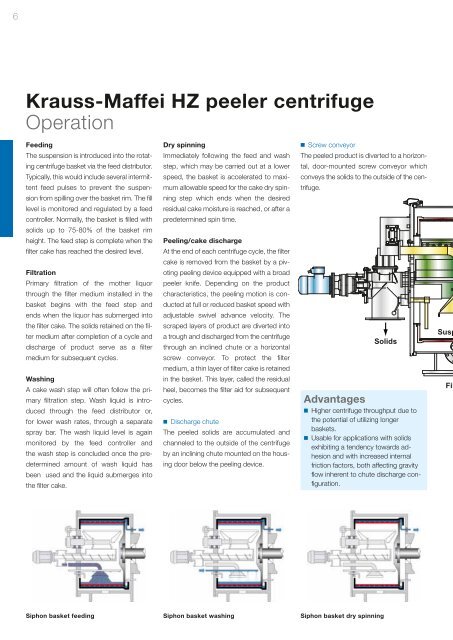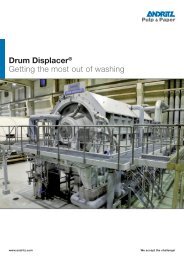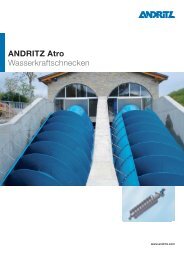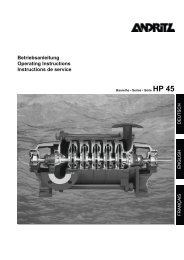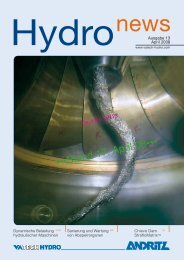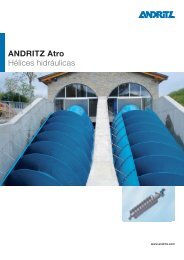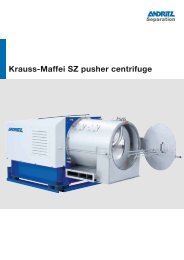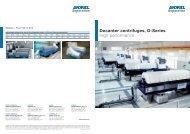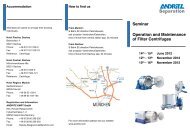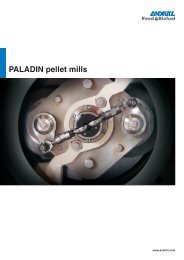Krauss-Maffei HZ peeler centrifuge - Andritz
Krauss-Maffei HZ peeler centrifuge - Andritz
Krauss-Maffei HZ peeler centrifuge - Andritz
You also want an ePaper? Increase the reach of your titles
YUMPU automatically turns print PDFs into web optimized ePapers that Google loves.
6<br />
<strong>Krauss</strong>-<strong>Maffei</strong> <strong>HZ</strong> <strong>peeler</strong> <strong>centrifuge</strong><br />
Operation<br />
Feeding<br />
The suspension is introduced into the rotating<br />
<strong>centrifuge</strong> basket via the feed distributor.<br />
Typically, this would include several intermittent<br />
feed pulses to prevent the suspension<br />
from spilling over the basket rim. The fill<br />
level is monitored and regulated by a feed<br />
controller. Normally, the basket is filled with<br />
solids up to 75-80% of the basket rim<br />
height. The feed step is complete when the<br />
filter cake has reached the desired level.<br />
Filtration<br />
Primary filtration of the mother liquor<br />
through the filter medium installed in the<br />
basket begins with the feed step and<br />
ends when the liquor has submerged into<br />
the filter cake. The solids retained on the filter<br />
medium after completion of a cycle and<br />
discharge of product serve as a filter<br />
medium for subsequent cycles.<br />
Washing<br />
A cake wash step will often follow the primary<br />
filtration step. Wash liquid is introduced<br />
through the feed distributor or,<br />
for lower wash rates, through a separate<br />
spray bar. The wash liquid level is again<br />
monitored by the feed controller and<br />
the wash step is concluded once the predetermined<br />
amount of wash liquid has<br />
been used and the liquid submerges into<br />
the filter cake.<br />
Dry spinning<br />
Immediately following the feed and wash<br />
step, which may be carried out at a lower<br />
speed, the basket is accelerated to maximum<br />
allowable speed for the cake dry spinning<br />
step which ends when the desired<br />
residual cake moisture is reached, or after a<br />
predetermined spin time.<br />
Peeling/cake discharge<br />
At the end of each <strong>centrifuge</strong> cycle, the filter<br />
cake is removed from the basket by a pivoting<br />
peeling device equipped with a broad<br />
<strong>peeler</strong> knife. Depending on the product<br />
characteristics, the peeling motion is conducted<br />
at full or reduced basket speed with<br />
adjustable swivel advance velocity. The<br />
scraped layers of product are diverted into<br />
a trough and discharged from the <strong>centrifuge</strong><br />
through an inclined chute or a horizontal<br />
screw conveyor. To protect the filter<br />
medium, a thin layer of filter cake is retained<br />
in the basket. This layer, called the residual<br />
heel, becomes the filter aid for subsequent<br />
cycles.<br />
■ Discharge chute<br />
The peeled solids are accumulated and<br />
channeled to the outside of the <strong>centrifuge</strong><br />
by an inclining chute mounted on the housing<br />
door below the peeling device.<br />
■ Screw conveyor<br />
The peeled product is diverted to a horizontal,<br />
door-mounted screw conveyor which<br />
conveys the solids to the outside of the <strong>centrifuge</strong>.<br />
Advantages<br />
Solids<br />
■ Higher <strong>centrifuge</strong> throughput due to<br />
the potential of utilizing longer<br />
baskets.<br />
■ Usable for applications with solids<br />
exhibiting a tendency towards adhesion<br />
and with increased internal<br />
friction factors, both affecting gravity<br />
flow inherent to chute discharge configuration.<br />
Siphon basket feeding Siphon basket washing Siphon basket dry spinning<br />
Susp<br />
Fil


